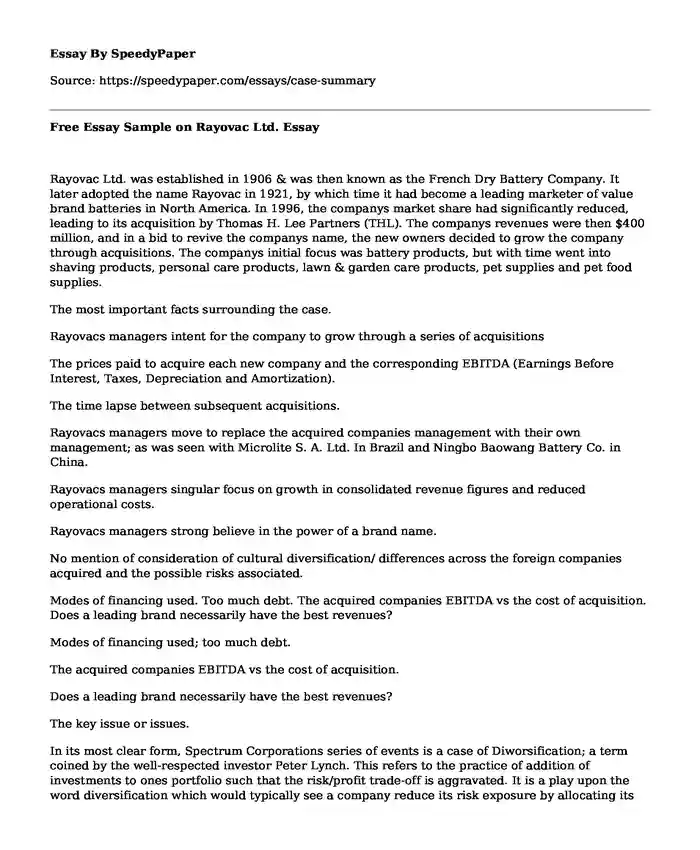
| Type of paper: | Essay |
| Categories: | Company Management |
| Pages: | 3 |
| Wordcount: | 814 words |
Rayovac Ltd. was established in 1906 & was then known as the French Dry Battery Company. It later adopted the name Rayovac in 1921, by which time it had become a leading marketer of value brand batteries in North America. In 1996, the companys market share had significantly reduced, leading to its acquisition by Thomas H. Lee Partners (THL). The companys revenues were then $400 million, and in a bid to revive the companys name, the new owners decided to grow the company through acquisitions. The companys initial focus was battery products, but with time went into shaving products, personal care products, lawn & garden care products, pet supplies and pet food supplies.
The most important facts surrounding the case.
Rayovacs managers intent for the company to grow through a series of acquisitions
The prices paid to acquire each new company and the corresponding EBITDA (Earnings Before Interest, Taxes, Depreciation and Amortization).
The time lapse between subsequent acquisitions.
Rayovacs managers move to replace the acquired companies management with their own management; as was seen with Microlite S. A. Ltd. In Brazil and Ningbo Baowang Battery Co. in China.
Rayovacs managers singular focus on growth in consolidated revenue figures and reduced operational costs.
Rayovacs managers strong believe in the power of a brand name.
No mention of consideration of cultural diversification/ differences across the foreign companies acquired and the possible risks associated.
Modes of financing used. Too much debt. The acquired companies EBITDA vs the cost of acquisition. Does a leading brand necessarily have the best revenues?
Modes of financing used; too much debt.
The acquired companies EBITDA vs the cost of acquisition.
Does a leading brand necessarily have the best revenues?
The key issue or issues.
In its most clear form, Spectrum Corporations series of events is a case of Diworsification; a term coined by the well-respected investor Peter Lynch. This refers to the practice of addition of investments to ones portfolio such that the risk/profit trade-off is aggravated. It is a play upon the word diversification which would typically see a company reduce its risk exposure by allocating its investments among varied industries, financial instruments etc. Yet that is exactly where the problem springs from, since diversifying too broadly puts the company at risk of ruining their initial business by losing their primary focus, as management energy, time and properties are sidetracked from the initial investment.
It primarily comes across as a management issue; which was evident in David A. Jones multiple remarks as the companys CEO. He strongly believes in brand name and acquiring companies with a strong brand name, focus on selling products at a price cheaper than their competitors - which to a good extent ignores the value of the marketing mix, his belief in seeing Spectrum become a more diversified consumer products company, etc.
The strategy of the company to grow through diversification is singularly biased. Whereas the financial reports may demonstrate a growth in revenue, there are other several underlying factors that are at play, such as changing market trends towards battery use, declining market share in some regions, replacing of local management with foreign management, who may be unfamiliar with country and company culture, amongst other things. Much as mergers and acquisitions seem to promise much, they are estimated to have a 50% chance of success.
Worse still, the greatest challenge Spectrum Corporation is yet to deal with is its managers divided attention across the different industries. The company seems to lack focus and is currently spreading out everywhere.
Alternative courses of action
This is subject to debate by many economists and investors alike, especially those with a bias towards diversification. The report on Spectrum Corporation even indicates how a number of analysts hailed their most recent acquisition.
Focusing on a single product/ industry is one option.
Stand to attain exponential growth
Management focus on primary product; streamlined management
Closing down some of its poorly performing acquisitions, such as Rov. Ltd.
Gain by saving on operational costs
Having local managers in their foreign acquisitions, rather than the Spectrum managers
Maintaining the status quo
Risk: Criteria of choosing company acquired which is mostly companys current market share in some cases, as well as current revenues, disregarding the companys promise to be dynamic & adaptable to the future market trends through innovation
Recommend the best course of action.
The best alternative to diversification, which often turns out to be diworsification, is to singularly choose a line of focus. From that point the company can have it in their strategic plan on the amount of time the company would focus on a particular product line, the different foreign companies it would then choose to acquire or merge with that are in the same industry across the globe and the Research & Development efforts it would put into this particular product line so as to remain relevant in the ever-evolving consumer market.
Cite this page
Free Essay Sample on Rayovac Ltd.. (2019, Aug 15). Retrieved from https://speedypaper.com/essays/case-summary
Request Removal
If you are the original author of this essay and no longer wish to have it published on the SpeedyPaper website, please click below to request its removal:
- Essay Example on How Conflicts Bring Out the Best and the Worst of Humanity
- Management Skills in Students - Essay Samples
- Free Essay on Short Term Versus Long Term Pricing Decisions for Business
- Free Essay: Public Transportation - A Necessary Expense or a Waste of Public Money?
- Analytical Essay on "A Rose for Emily", Free Example
- Surgery at the Hands of a Robot - Article Review Paper Example
- Free Essay on John Lock's View on Marriage
Popular categories




